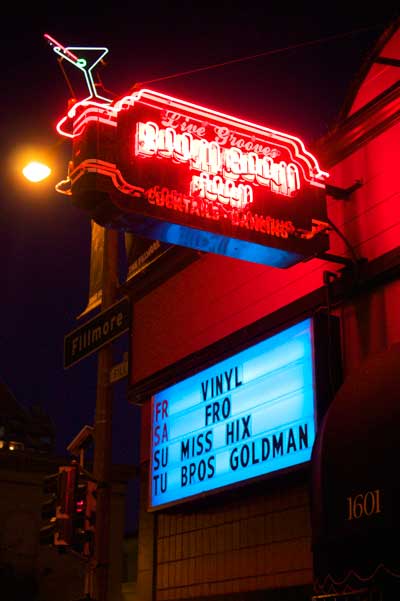
Photographs of the Boom Boom Room by Susie Biehler
SALOONS | CHRIS BARNETT
A t the Boom Boom Room, the divey-looking 78-year-old live music club on Fillmore at Geary, the best seat in the house is off limits to customers. The tufted red leather booth, with its perfect view of the band and dance floor, is permanently reserved for legendary blues guitarist John Lee Hooker, who some claim once owned the joint. Yet it’s unlikely he’ll show up these days, for even the hottest act. John Lee died in 2002.
“Well, maybe to you he’s dead. But not to me,” insists Hooker’s longtime business partner and the Boom Boom Room’s current owner, Alexander Andreas.
Andreas claims clubgoers have offered as much as $600 for Hooker’s booth — instead of the red vinyl bar stools or the 35-foot leather banquette that runs along the south wall. But the bids all fall on deaf ears. “It’s not for sale,” he says.
John Lee may now be strumming at the Big Bad Blues Bar in the Sky, but his Boom Boom Room on Fillmore is very much alive and kicking it every night except Monday.
Opened in 1933 as Jack’s Tavern at 1931 Sutter Street, across from Cottage Row, it was the first live music club that welcomed blacks in what would become, during World War II, the Fillmore jazz district. The music has since strayed far and wide from the original wailings of Chicago and New Orleans style jazz and blues. Soloists, duos, trios and full blown bands today belt out everything from R&B, funk, soul, boogie, salsa, rock, hip-hop and boogaloo to booty-shaking sounds that defy classification.
Andreas distills it down to “soul-centric, on-your-feet roots music.”
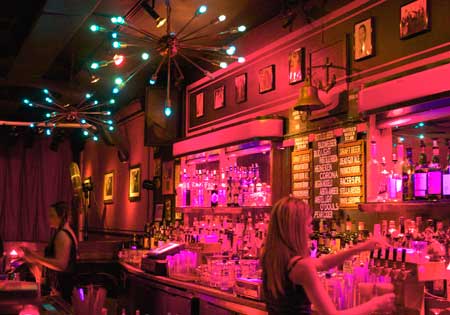
One thing is certain: The Boom Boom Room has the best happy hour — make that happy hours — on the street. At 4 p.m., 10 draught beers start flowing at $3 a pint. No taps for boring Bud or puny Miller Light here; they’re mainly Northern California microbrews sporting names like Arrogant Bastard, Downtown Brown, Dead Guy Ale and White Lightning. The same three bucks will get you a bottle of Pabst, Heineken, Corona, Negro Modello, Amstel Light and non-alcoholic O’Doul. Well drinks and wine are also priced at $3, but don’t look for Far Niente or Jordan; the wines here are a step up from the stuff that comes in a box. Happy hour ends at 8 p.m. and prices revert back to about $5 to $7.
The Boom Boom Room isn’t really a cocktail bar, although it does mix the classic martinis, sazaracs and manhattans.
But the stand up and shake it clientele here is a beer and whiskey crowd, anyway. When they opt for something stronger, it’s usually bourbon, scotch, vodka or rum straight or with a mixer. Barkeeps have no time to tinker with six or seven ingredients and customers don’t have the patience to wait for it. The creativity is on stage, not in the glass.
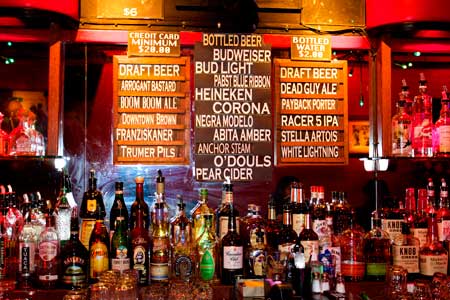
The best time to drop into the Boom Boom Room is around 6 p.m. when the band performing for the night will be tuning up and riffing, the crowd has not yet gathered, happy hour prices are in effect and no one is collecting admission. The cover charge, ranging from $5 to $20 depending on the day of the week and the performers, starts at 9 p.m. along with the show. There’s no cover on Sundays and Tuesdays.
Three hours before showtime is a lot like dress rehearsal; you see the room in all its naked glory. Beer boxes are strewn around. The house lights are tested, sound checks are taken, the mood of the place keeps changing. The band itself seems to shrink and expand before your very eyes. It often does. Andreas says musicians playing the Fillmore Auditorium and other clubs will frequently swing by and sit in with the band, often unexpectedly, for a song, a set or for the night.
Before the first downbeat is also a good time to check out the art: faded black and whites of greats from another era, recent color photos, some paintings of John Lee Hooker himself and a potpourri of photos of national treasures and local heroes, randomly hung. Among them are Buddy Miles, Fillmore’s own Etta James and Muddy Waters and his band, who were snapped at a recording studio that once stood on the corner of Pierce and Bush. Andreas himself took some of the photos, and others are by the great San Francisco rock photographer Jim Marshall.
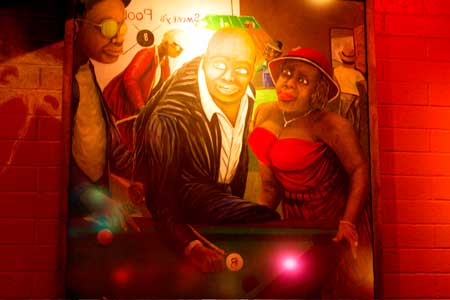
When the music starts, the Boom Boom Room roars to life. Candles flicker in squatty red hurricane lamps on every table and along the bar. The overhead spots bathe the rich velvet stage drape in blood red and give the musicians a soft amber glow. The powerhouse sound system sounds like Dolby on steroids. The spinning disco ball throws off a kaleidoscope of mirrored images. Two Sputnik light fixtures over the bar radiate an odd but soothing turquoise. The sensation is just this side of psychedelic.
On a recent Saturday night, Andreas, 43, sporting a black T-shirt, was drinking in the scene along with a Maker’s Mark on the rocks, clearly pleased.
“You’ll notice everything’s curved here — the bar, banquettes, the leather upholstered automobile bumpers over the backbar,” he notes. Amazingly, the car bumpers fit right into the decor. So do the two dozen small brass plaques affixed to the bar in front of every stool — tiny tributes saluting some of Fillmore’s colorful characters by their street names: Chili Joe, Trumpet, the Lawman, Cable Car Joe, Nash, Mashed Potato George and Big Earl.
“Trumpet carried a trumpet case but he never played the trumpet,” Andreas recalls. “He was a bartender when this was Jack’s Bar on Sutter.” He also recalls the case was packed with loaded dice for the pick-up games he always had going in an alley near Jack’s — that is, until one of the perennial losers examined the “bones.”
The brass plaques, the framed photos, the tales of yesteryear, the DJ station just inside the front door and the juke box that hangs on the wall at the east end of the backbar are all ways the Boom Boom Room is doing its part to make sure the giants and the unknowns of jazz and blues and their music will never be forgotten.
Andreas puts it his way: “This place is dedicated to the pioneers, originators and legends, both old and new — the famous musicians and the up-and-coming artists.”
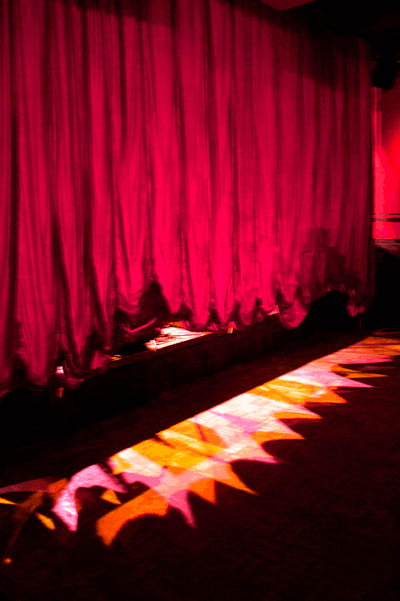
Read more: “Was it really John Lee Hooker’s joint?“
Filed under: Food, Drink & Lodging, Landmarks, Neighborhood History





